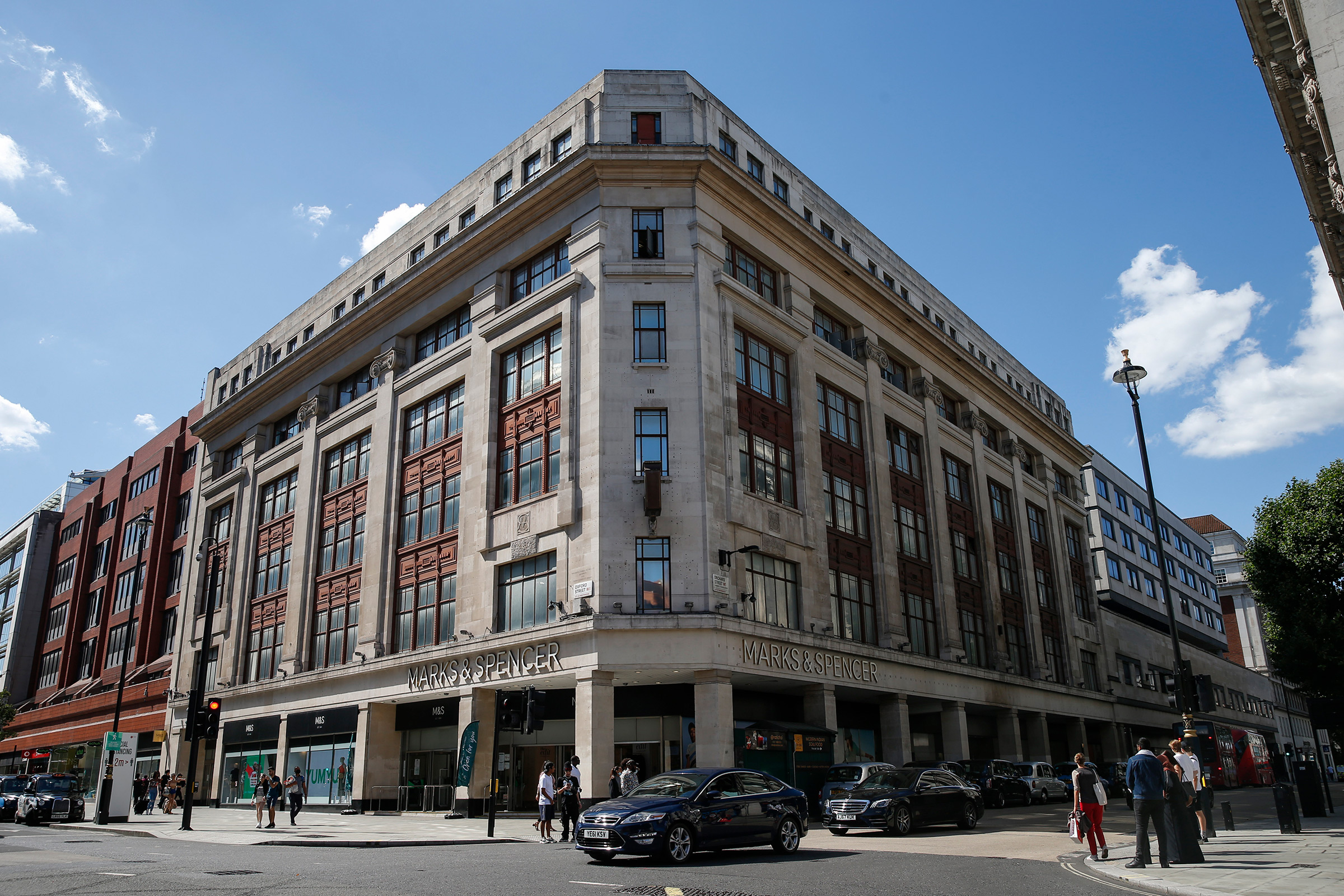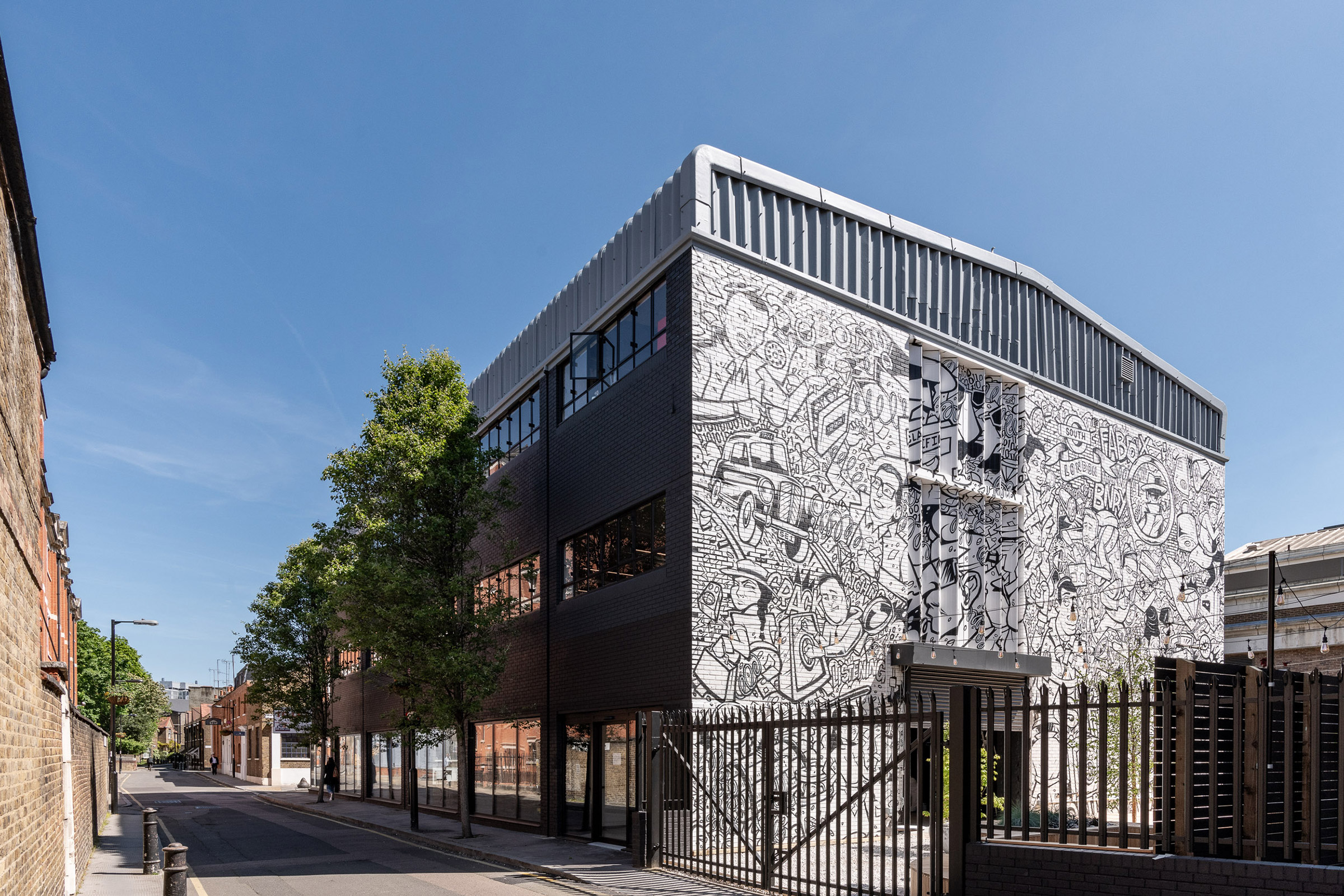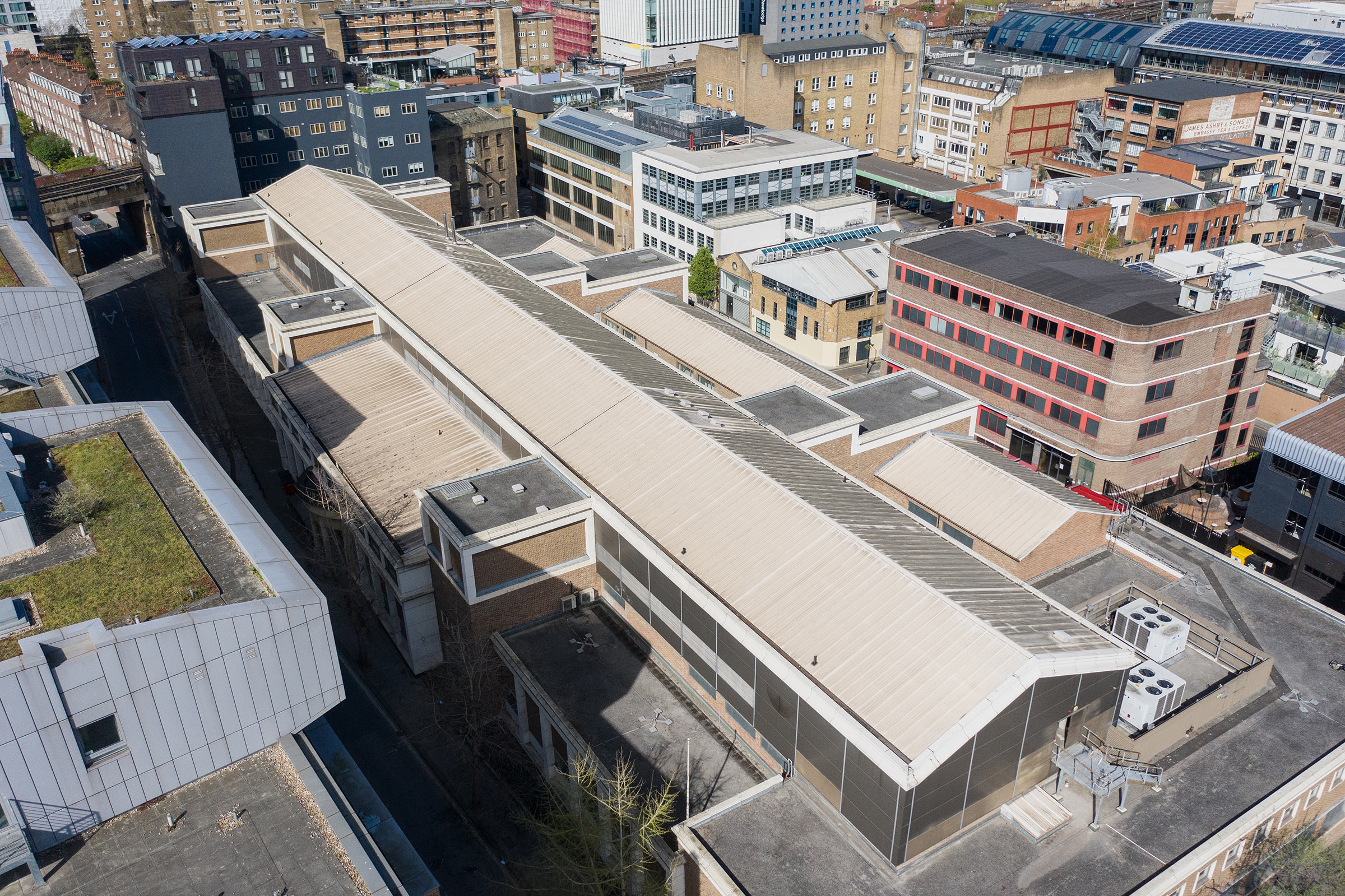
An unusual conservation battle is brewing on Oxford Street, London’s busy shopping avenue. Marks and Spencer, a British retail giant famous for high quality groceries and affordable homeware, wants to knock down its flagship store and replace it with a shiny new one. A group of architects and local activists have mobilized to save the store—not because it’s beautiful, or historic, or even particularly beloved. But because of the climate.
To build a new building, you need materials like steel and concrete, the production of which releases vast amounts of carbon dioxide. And you also need lots of fossil-fueled energy to transport and assemble them. Critics say M&S—as the retailer is affectionately known in the U.K.—is about to throw away a perfectly good set of buildings (three make up the site, built in the 1930s, ‘60s and ‘80s), which could be refurbished instead. Unnecessary demolitions and re-builds, they argue, aren’t compatible with the U.K.’s target to rapidly cut greenhouse gas emissions by 78% by 2035, and reach net-zero by 2050.
“We can’t continue to develop in a 20th century fashion,” says Simon Sturgis, an architect and environmental consultant. “Buildings are resources that we need to value: whether it’s a nice art deco structure or a pretty grim 1970s block, is not the point.”
In an unprecedented move, in April, the U.K.’s housing minister ordered a halt to M&S’ demolition while the government considers evidence over their redevelopment’s carbon footprint. In June, he called a public inquiry into the plan, scheduled for October.
M&S’ struggle to demolish reflects a revolution currently taking place across the construction sector. For a long time, architects, developers, and builders concerned about climate change have focused almost exclusively on making buildings energy efficient, to reduce the need for fossil fuels to heat, cool, and power them. (M&S argues that its new building would be less polluting to run than the old ones.) But in the last few years, as the urgency of cutting emissions has grown, attention has shifted to all the carbon emitted during construction, before a tenant even gets the keys to a building: this so-called “embodied carbon” from the construction industry makes up a staggering 11% of global carbon emissions according to the World Green Building Council (WGBC), a nonprofit.
Since there aren’t many zero-carbon construction technologies available yet, one of the easiest ways to cut embodied carbon is simply to build less. Or, as anti-demolition campaigners say: “The greenest building is one that already exists.”
In Europe, which has both a massive stock of buildings and some of the world’s most ambitious climate goals, environmental imperatives are triggering a fundamental rethink of construction. In March, London’s mayor issued new guidelines which require developers to prioritize “retaining existing built structures for reuse and retrofit,” and to prove that they have a good reason for any substantial demolition.
Read more: Follow the Algae Brick Road to Plant-Based Buildings
On the continent, flashy new construction projects are facing a fierce backlash. Paris’ green party has labeled a forthcoming toblerone-shaped skyscraper, designed by renowned Swiss studio Herzog & de Meuron, an “ecological aberration.” Meanwhile, tastemakers are praising those who avoid building: in 2021 the Pritzker prize, architecture’s most prestigious award, went to Lacaton and Vassal, a French couple famous for retrofitting unused social housing, whose motto is “never demolish.”
“The whole discourse has changed in just three years,” says Hattie Hartman, sustainability editor at the Architects’ Journal (AJ), which has run a campaign calling on architects to “retrofirst”—making reuse of old buildings the default. “The first question now should be: ‘do we need a new building?’ That’s turning the thought process of the profession upside down.”

Reusing buildings is nothing new. Many cities have adapted charming historic buildings for new uses. In New York and London, for example, brick factories and warehouses make for stylish loft apartments, while Amsterdam’s Schiphol bus station is a repurposed WWII-era aircraft hangar. But such projects are usually the exception. When it comes to buildings without clear historical value, or those built in now unfashionable late 20th century architectural eras, developers often see an obstacle to clear. Some structures aren’t safe to reuse, but experts say many of the 50,000 buildings demolished in the U.K. each year are lost unnecessarily.
Clive Nichol is one of the people trying to save the ugly buildings. In 2016, he founded Fabrix, a London-based developer which has emerged as an industry leader in reuse and retrofit. Soon after, Fabrix acquired a distinctly unattractive 1980s brick block, with three stories and few windows. The building, in Southwark, just south of the River Thames, once housed a police cyber security unit. “Everybody trying to buy it wanted to demolish it. Because if you look at that,” Nichol says, holding up a “before picture” as he stands in the street opposite the building in late June. “No one thinks that could be something.”
Fabrix didn’t lay a single brick at the building, which they renamed The Binary. They enlarged the windows, replaced the parking lot with a garden, removed internal partitions to open up new space, and stripped back the ceilings to add height. They also introduced new electric heating and cooling systems, allowing the building to be powered entirely by renewable energy. The space was quickly rented out by three businesses as offices. Fabrix says avoiding a demolition and rebuild of the relatively small building prevented 193 metric tons of CO2 from being emitted—the equivalent of taking 120 cars off the road in the U.S.—and 600 metric tons of construction waste going to landfill. Those might not sound like colossal numbers, but advocates say that if retrofit over demolition became the norm in the construction industry, they would add up quickly.
Nichol has set about spreading his gospel in the neighborhood. A charity next door had plans to tear down its similarly unattractive five story building, because they wanted to replace it with a seven-story one, until Nichol persuaded them to retrofit instead. “From a carbon point of view,” he says, “but also in terms of time, money, and all the upset in the neighborhood in terms of waste and air quality, that’s kind of an easy one.”
The biggest obstacle to keeping buildings standing may just be a lack of imagination on the part of developers, says Nichol. “It takes a lot more thought to retrofit,” Nichol says. “You’ve got to make many more decisions about how to repurpose things, fix things, within a lot of constraints.”
To understand the challenge, imagine you had a dollhouse growing up, and maybe you abused it a little: you glued other toys to it, graffitied some walls. And after sitting in your parents’ attic for 25 years, it’s looking pretty beat-up. Now, your own child wants a dollhouse for their birthday. Are you going to spend weeks painstakingly fixing yours up for them? Or throw it in the trash and get the new one they saw at the store?

It’s not always straightforward to decide if a building should be saved. Though some say “never demolish,” the demands of a dense, growing city sometimes means demolition may be necessary, Nichol argues; either to allow for land to be used better for the local community, or for the size of a building to be dramatically expanded. “I think [local governments] need to set rules on that on a planning scale,” he adds.
Fabrix’s latest project is the redevelopment of a large former court building around the corner from The Binary. After acquiring the court in 2020, Fabrix decided to retain the façade, but demolish and rebuild the inside. The reasons are twofold: a) no one has any use for a building designed to be a court; and b) the existing structure couldn’t support the 1,000 metric tons of soil that Fabrix plans to put on the roof to build an urban forest open to the local community. Unlike most “rooftop gardens,” which place plants in a thin layer of soil or pots, the trees will be able to put down roots, and therefore live longer. (The project is called, a little cheesily, “Roots in the Sky.”)
Read more: Homes Made from Straw or Fungi Can Now Get You a Cheaper Mortgage in the Netherlands
There are ways to limit the climate impact of construction, even when you don’t retain an entire building. At the court redevelopment, Fabrix will use 30 metric tons of steel recovered from another construction site, which it is having specially recertified by safety bodies in the U.K., hoping to save up to 80% of the carbon emissions of using only virgin steel. Concrete used in the building will contain 96% recycled cement, saving 7,000 metric tons of CO2—the annual emissions of around 1,500 cars. And where technically feasible, the crew will use bolts instead of welded connections, to make it easier for future projects to take parts from the building if it’s ever taken down.
Those techniques center around “deconstruction”—the careful dismantling of buildings to allow for their parts to be reused. Nichol estimates that it costs Fabrix 20% more to take down its building in this way, compared to a quick levelling by a demolition truck. In the U.K., he adds, the supply chain for recertifying materials, instead of scrapping them, is only in its infancy.
That supply chain problem is starting to improve in some places: a handful of cities, including Portland, Ore., and Palo Alto, Calif., have introduced rules requiring demolition companies to carefully deconstruct certain kinds of buildings. Amsterdam and Paris, meanwhile, require developers and architects to design with future deconstruction in mind: imagine a lego set replacing your dollhouse.
By and large, however, regulators have been surprisingly slow to tackle the construction industry’s outsized carbon emissions, compared to other polluting sectors like transport and agriculture, says Stephen Richardson, Europe director at the WGBC. “The problem is the complexity, and a lack of data.” In most countries, developers aren’t even required to measure the carbon footprint of their projects. That makes it hard to assess where industry averages lie, or to set targets for what a green building should be aiming for. And, even if developers have an estimate of their new building’s carbon footprint, it’s hard to prove that it will be more environmentally damaging than keeping the old one.
The M&S case helps to understand the confusion. The retailer says that a report carried out by an independent environmental consultant concluded that demolishing and rebuilding the site “offered significant sustainability advantages over a refurbishment.” It claims that, because the new building will require less energy to run and won’t need as many repairs as the old one, it will offset the emissions from redevelopment within 16 years. But Sturgis, the architect opposing M&S’ plan, says that calculation assumes that the refurbishment option “would be essentially a lick of paint” with few measures to improve the building’s performance, and would need to be repeated after a few years. M&S declined TIME’s request for an interview.
Sturgis says the company needs to carry out a more hands-on, long-lasting refurbishment, by upgrading the internal layout to modern standards, adding insulation, double glazing, and more carbon-efficient heating and cooling systems. According to his analysis, compared to a redevelopment, a comprehensive retrofit would cut the site’s carbon emissions—from both construction and day-to-day operation of the building—nearly in half over the coming decades. The greatest carbon savings would come in the next few years, when the urgency of limiting the greenhouse effect is greatest.
“Having done this work, I know it’s not necessarily the cheapest, easiest, and cleanest,” says Sturgis, who led retrofit projects as an architect. “But it can be done.”

A new generation of architects is getting serious about their profession’s contribution to the climate crisis. The Architects Climate Action Network (ACAN), founded in the U.K. in 2019, is made up of several hundred mostly young architects across Europe, working to convince the firms where they work and the architecture schools where they study to focus on embodied carbon and prioritize retrofits. “My generation and people younger than me have a lot more climate anxiety, so we feel like it’s our responsibility to make the industry change,” says Zafir Ameen, who has helped lead ACAN’s student network and works in a London-based firm.
Ameen says he’s seen a rapid shift in the industry’s awareness of embodied carbon since he started work in 2019. Awards bodies increasingly demand that firms submit embodied carbon measurements if they want their buildings recognized, he says. And some practices have developed digital tools that allow architects to estimate the footprint of their buildings from the earliest stages of design. Meanwhile, academic researchers have published a flurry of studies in the last twelve months that try to work out the average carbon cost of a new building and set targets for the industry to balance embodied carbon and improvements to energy efficiency.
European regulators are also catching up. Since 2020, France, Finland, and Sweden have each began requiring developers to submit assessments of their projects’ construction carbon footprint to get planning permission, joining the Netherlands, which has required the measurement since 2013 (in most countries, however, permission is linked only to the carbon emissions that will be generated while the building is in use.) The E.U. is considering adding a similar policy to existing bloc-wide legislation on energy efficiency in buildings. In theory, projects deemed too carbon-intensive should be blocked under such planning regimes—though Richardson, of the WGBC, says it’s too early to tell if that is happening.
For now, the biggest factor favoring retrofits over new builds may be a business one, according to Nichols. The post-pandemic shift to homeworking has wreaked havoc on commercial real estate, and green credentials are an important advantage for developers trying to stand out in a newly competitive market, he says. “It is more expensive to create buildings like this, but it also creates less risk: there are an enormous number of organizations that have net-zero targets now, who want office space that can help them with that. So we know there’s demand for our buildings.”
If developers like Fabrix succeed, they could help both the building industry and the general public embrace an aesthetic shift towards sustainability, says Hartman, the AJ editor. “Retrofitting is not always sexy, high-concept architecture, but you can get some fantastic results,” Hartman says. “We need to shift our idea of what we think is beautiful.”
More Must-Reads From TIME
- The 100 Most Influential People of 2024
- How Far Trump Would Go
- Scenes From Pro-Palestinian Encampments Across U.S. Universities
- Saving Seconds Is Better Than Hours
- Why Your Breakfast Should Start with a Vegetable
- 6 Compliments That Land Every Time
- Welcome to the Golden Age of Ryan Gosling
- Want Weekly Recs on What to Watch, Read, and More? Sign Up for Worth Your Time
Write to Ciara Nugent at ciara.nugent@time.com